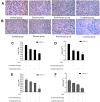Down-Regulation of Hypoxia-Inducible Factor-1α and Downstream Glucose Transporter Protein-1 Gene by β-elemene Enhancing the Radiosensitivity of Lung Adenocarcinoma Transplanted Tumor
- PMID: 33223837
- PMCID: PMC7671467
- DOI: 10.2147/OTT.S275956
Down-Regulation of Hypoxia-Inducible Factor-1α and Downstream Glucose Transporter Protein-1 Gene by β-elemene Enhancing the Radiosensitivity of Lung Adenocarcinoma Transplanted Tumor
Abstract
Purpose: To study the effect of β-elemene on the radiosensitivity of A549 cell xenograft tumor and potential mechanisms by which β-elemene regulates the expression of hypoxia-inducible factor-1α (HIF-1α) and glucose transporter protein-1 (GLUT-1).
Methods: Using an A549 cell transplantation tumor model with male nude mice, we studied the effect of β-elemene on the radiosensitivity of non-small cell lung cancer (NSCLC). The expression of HIF-1α and GLUT-1 was detected by real-time PCR, Western blotting and immunohistochemistry. The relationship between the radiosensitivity of β-elemene and the expression of HIF-1α and GLUT-1 was analyzed.
Results: β-elemene and radiotherapy intervened in the growth of transplanted tumors in varying degrees. The enhancement factor (EF=2.44>1) was calculated; β-elemene at 45 mg/kg had the most significant enhanced effect on radiosensitivity. When β-elemene was used in combination with radiation, the expression of HIF-1α and GLUT-1 was significantly decreased, and there was a positive correlation between the two genes.
Conclusion: β-elemene exhibits a radiosensitizing effect on A549 cell xenograft tumor. The underlying molecular mechanism is probably associated with the down-regulation of HIF-1α and GLUT-1 expression, suggesting that β-elemene may directly or indirectly inhibit the expression of HIF-1α and GLUT-1. There is a positive significant correlation between expression of HIF-1α and GLUT-1. HIF-1α and downstream GLUT-1 could be used as a new target for the radiosensitization of NSCLC.
Keywords: GLUT-1; HIF-1α; radiosensitivity; transplanted tumor; β-elemene.
© 2020 Wu et al.
Conflict of interest statement
The authors report no conflicts of interest in this work.
Figures




Similar articles
-
In vivo evaluation of the effects of simultaneous inhibition of GLUT-1 and HIF-1α by antisense oligodeoxynucleotides on the radiosensitivity of laryngeal carcinoma using micro 18F-FDG PET/CT.Oncotarget. 2017 May 23;8(21):34709-34726. doi: 10.18632/oncotarget.16671. Oncotarget. 2017. PMID: 28410229 Free PMC article.
-
Down-regulation of survivin and hypoxia-inducible factor-1 α by β-elemene enhances the radiosensitivity of lung adenocarcinoma xenograft.Cancer Biother Radiopharm. 2012 Feb;27(1):56-64. doi: 10.1089/cbr.2011.1003. Epub 2012 Jan 16. Cancer Biother Radiopharm. 2012. PMID: 22248028 Clinical Trial.
-
Correlation between ¹⁸F-FDG uptake and the expression of glucose transporter-1 and hypoxia-inducible factor-1α in transplanted VX2 tumors.Nucl Med Commun. 2013 Oct;34(10):953-8. doi: 10.1097/MNM.0b013e328364a9e2. Nucl Med Commun. 2013. PMID: 23887273
-
The effects of β-elemene on the expression of mTOR, HIF-1A, survivin in lung adenocarcinoma A549 cell.Afr J Tradit Complement Altern Med. 2013 May 16;10(4):18-23. doi: 10.4314/ajtcam.v10i4.4. eCollection 2013. Afr J Tradit Complement Altern Med. 2013. PMID: 24146496 Free PMC article.
-
MicroRNAs-mediated regulation of glucose transporter (GLUT) expression in glioblastoma.Noncoding RNA Res. 2022 Sep 6;7(4):205-211. doi: 10.1016/j.ncrna.2022.09.001. eCollection 2022 Dec. Noncoding RNA Res. 2022. PMID: 36157351 Free PMC article. Review.
Cited by
-
HAX1 maintains the glioma progression in hypoxia through promoting mitochondrial fission.J Cell Mol Med. 2021 Dec;25(24):11170-11184. doi: 10.1111/jcmm.17038. Epub 2021 Nov 10. J Cell Mol Med. 2021. PMID: 34755451 Free PMC article.
-
Anti-Cancer Activity of Phytochemicals Targeting Hypoxia-Inducible Factor-1 Alpha.Int J Mol Sci. 2021 Sep 10;22(18):9819. doi: 10.3390/ijms22189819. Int J Mol Sci. 2021. PMID: 34575983 Free PMC article. Review.
-
HIF-1α is an important regulator of IL-8 expression in human bone marrow stromal cells under hypoxic microenvironment.Protoplasma. 2024 May;261(3):543-551. doi: 10.1007/s00709-023-01920-z. Epub 2023 Dec 23. Protoplasma. 2024. PMID: 38135806
-
Curcumae Rhizoma: An anti-cancer traditional Chinese medicine.Chin Herb Med. 2025 Apr 24;17(3):428-447. doi: 10.1016/j.chmed.2025.04.006. eCollection 2025 Jul. Chin Herb Med. 2025. PMID: 40734908 Free PMC article. Review.
References
LinkOut - more resources
Full Text Sources
Research Materials
Miscellaneous

